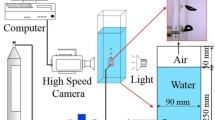Abstract
Transient behavior of a bed collapsing after cut-off of gas supply into a three-phase fluidized bed was determined in a 0.21 m-diameter half-tube acrylic column having a test section 1.8 m high. The transient behavior of the bed collapse after cut-off of the gas supply to the beds was monitored by a video camera (30 frames/s). A theory was developed to account for the dynamic behavior of the bed collapse after the gas supply shut-off to three-phase fluidized beds. The bubble drift velocity was theoretically calculated by gas and liquid phase holdups at steady state condition. At a liquid velocity of 0.103 m/s and gas velocity of 0–0.023 m/s, bubble size was uniform in the dispersed bubble flow regime. However, as the gas velocity increased above 0.023 m/s, the discrete or coalesced bubble flow regime could be observed. The agreement between the predicted and experimental values is acceptable in the dispersed bubble flow regime, but the agreement becomes poorer with increasing gas velocity.
Similar content being viewed by others
References
Begovich, J. M. and Watson, J. S.,Hydrodynamic Characteristics of Three-Phase Fluidized Beds, Fluidization, Davidson, J. F. and Keairns, D. L. eds, Cambridge University Press, Cambridge, U. K., 190 (1978).
Bhatia, V.K. and Epstein, N.,Three-Phase Fluidization: A Generalized Wake Model, Fluidization and Its Applications, Cepadeus-Editions, Toulouse (France), 380 (1974).
Chen, Y. M. and Fan, L. S., “Drift Flux in Gas-Liquid-Solid Fluidized Systems from the Dynamics of Bed Collapse,”Chem. Eng. Sci.,45, 935 (1990).
Chern, S.-H., Fan, L.-S. and Muroyama, K., “Hydrodynamic of Cocurrent Gas-Liquid-Solid Semifluidization with Liquid as the Continuous Phase,”AIChE J.,30, 288 (1984).
El-Temtamy, S. A. and Epstein, N., “Rise Velocities of Large Single Two-Dimensional and Three-Dimensional Gas Bubbles in Liquids and in Liquid-Fluidized Beds,”Chem. Eng. J.,19, 153 (1980).
Fan, L. S.,Gas-Liquid-Solid Fluidization Engineering, Butterworth, Stoneham, MA (1989).
Han, H.D., Lee, W., Kim, Y.K., Kwon, J. L., Choi, H. S. and Kang, Y., “Phase Holdup and Critical Fluidization Velocity in a Three-Phase Inverse Fluidized Bed,”Korean J. Chem. Eng. 20, 163 (2003).
Han, J.H., Wild, G. and Kim, S.D., “Phase Holdup Characteristics in Three-Phase Fluidized Beds,”Chem Eng. J. 43, 67 (1990).
Jin, Y. and Zhang, J. P., “Bed Collapse Technique for Estimating Parameters of Generalized Wake Model for a Three-Phase Fluidized Bed,” Proc. 5th Chinese National Fluidization Conference, Beijing, 327 (1990).
Kim, S.D., Baker, C.G. J. and Bergougnou, “Holdup and Axial Mixing Characteristics of Two and Three Phase Fluidized Beds,”Can. J. of Chem. Eng.,50, 695 (1972).
Kwauk, M.,Fluidization: Idealized and Bubbleless, with Application, Science Press and Ellis Horwood, Beijing (1992).
Larachi, G., Beltares, L., Iliuta, I. and Grandjean, B. P.A., “Three-Phase Fluidization Macroscopic Hydrodynamics Revisited,”Ind. Eng. Chem. Res.,40, 993 (2001).
Lee, D.H., Epstein, N. and Grace, J.R., “Hydrodynamic Transition from Fixed to Fully Fluidized beds for Three-Phase Inverse Fluidization,”Korean J. Chem. Eng.,17, 684 (2000).
Lee, D. H., Park, S. S., Choi, W.W., Kim, D. J., Kim, J.-H., Lee, Y. K., Sim, S. J. and Kim, S.D., “Dynamic Characteristics of Bed Collapse in Three-Phase Fluidized Beds,”Korean J. Chem. Eng.,20, 1166 (2003).
Lee, D. L., Kim, J. O. and Kim S. D., “Mass Transfer and Phase Holdup Characteristics in Three-Phase Fluidized Beds,”Chem. Eng. Comm.,119, 179 (1993).
Maucci, E., Briens, C. L., Martinuzzi, R. J. and Wild, G., “Detection and Characterization of Piston Flow Regime in Three-Phase Fluidized Beds,”Powder Techn.,103, 243 (1999).
Park, S.H. and Kim, S.D., “Experimental, Statistical and Stochastic Studies of Pressure Fluctuations in a Three-Phase Fluidized Bed with a Moderately Large Diameter,”Korean J. Chem. Eng.,20, 121 (2003).
Saberian-Beoudjenni, M., Wild, G., Charpentier, J. C., Fortin, Y., Euzen, J.-P. and Patoux, R., “Contribution to the Hydrodynamics Study of Fluidized Gas-Liquid-Solid Reactors,”Entropie,120, 30 (1984).
Zhang, J. P., Grace, J. R. and Epstein, N., “Flow Regime Identification in Gas-Liquid Flow and Three-Phase Fluidized Beds,”Chem Eng. Sci.,52, 3979 (1997).
Author information
Authors and Affiliations
Corresponding author
Rights and permissions
About this article
Cite this article
Park, S.S., Kang, S.M., Lee, D.H. et al. Bubble drift velocity from the bed collapse technique in three-phase fluidized beds. Korean J. Chem. Eng. 22, 328–333 (2005). https://doi.org/10.1007/BF02701505
Received:
Accepted:
Issue Date:
DOI: https://doi.org/10.1007/BF02701505




